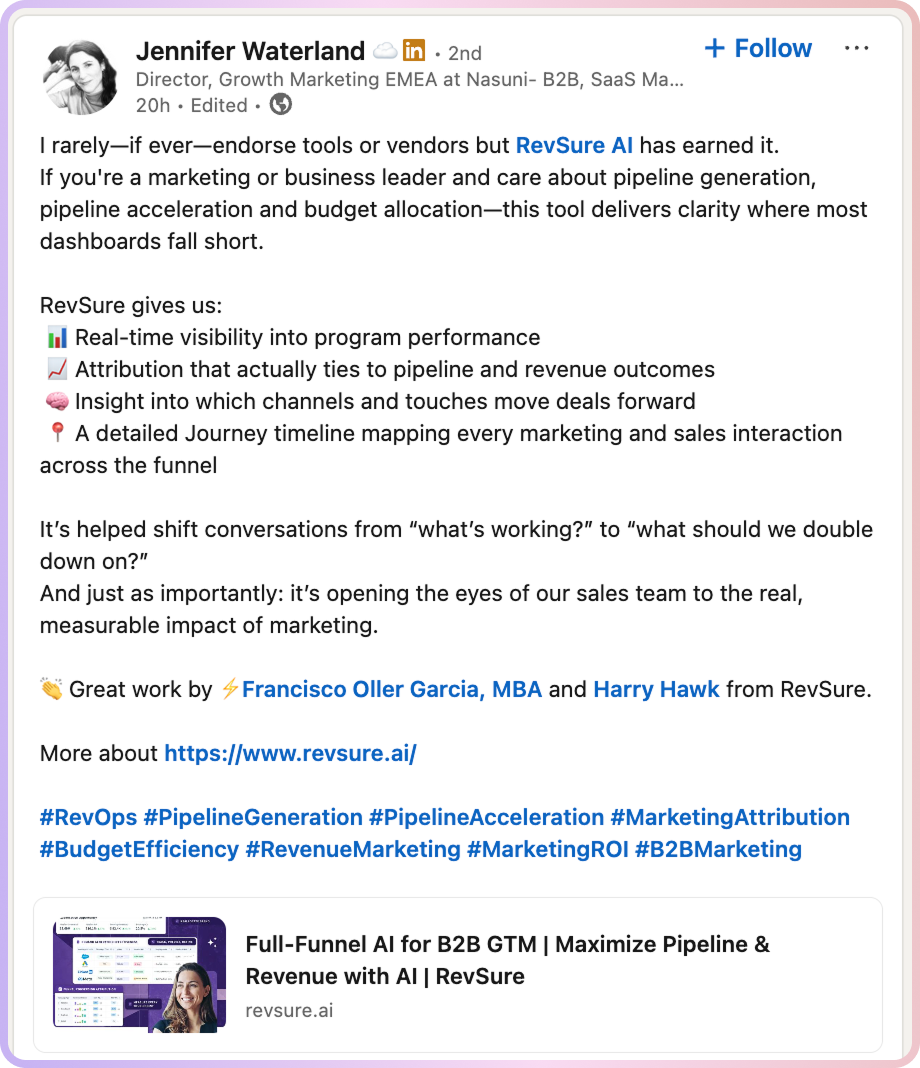

Book a Demo
Thank you! Your submission has been received!
Oops! Something went wrong while submitting the form.
Traditional marketing dashboards were not built for today’s revenue environment. They were designed to track activity, not impact. To capture basic conversions, not journey dynamics. And while they continue to report on impressions, clicks, and leads, they often fall short of answering the questions modern B2B leaders care about most:
As organizations face increased pressure to justify spend, accelerate pipeline, and align with sales, these limitations are no longer acceptable.
The issue is not a lack of data, but a lack of clarity. Many GTM teams are pulling information from multiple systems: CRMs, marketing automation platforms, paid media dashboards, event tools, content engagement trackers, and more. But stitching this data into a coherent, actionable view often requires manual work, time-consuming analysis, and educated guesswork. The result: teams spend more time aligning on metrics than acting on them.
There are three consistent gaps in legacy dashboard approaches:
This visibility gap affects more than marketing. When attribution lacks credibility, sales is skeptical, finance withholds budget, and GTM teams operate without a shared understanding of what’s working.
Today’s B2B revenue teams require more than better reporting; they need reliable, real-time answers to critical business questions. Visibility must evolve from descriptive to diagnostic and predictive. This means:
When teams can’t access this level of insight, they default to decisions based on opinion, habit, or incomplete data.
Jennifer Waterland, Director of Growth Marketing EMEA at Nasuni, recently captured this shift in a public endorsement of RevSure:
“If you're a marketing or business leader and care about pipeline generation, pipeline acceleration and budget allocation—this tool delivers clarity where most dashboards fall short.”
“It’s helped shift conversations from ‘what’s working?’ to ‘what should we double down on?’ And just as importantly: it’s opening the eyes of our sales team to the real, measurable impact of marketing.”
The challenge isn’t simply accessing data. It’s drawing the right conclusions in real-time and taking decisive action. This is where traditional dashboards fail, and where purpose-built full-funnel platforms step in. Read the full post: Jennifer Waterland on LinkedIn

RevSure is designed specifically for modern B2B GTM teams who need visibility across the full funnel and the ability to act on it. It unifies marketing, sales, and engagement data into a single platform that delivers attribution tied to actual outcomes. Here’s how:
Attribution that reflects how deals move
RevSure tracks which programs, channels, and touches influence movement between funnel stages—MQL to SQL, SQL to opportunity, opportunity to closed-won. Rather than giving credit to the first or last touch, RevSure highlights what accelerated the deal.
Buyer journey mapping across all personas
Rather than focusing on individual leads, RevSure provides a timeline of all buyer interactions across an account, lead, or opportunity—marketing emails, sales calls, paid campaigns, content views, and more. This gives teams a complete picture of how different personas contributed to progression.
Program performance insights
RevSure surfaces program and campaign performance continuously, not quarterly. Teams can see what’s working now, without waiting for an analyst or ops team to build a report.
Budget and reallocation recommendations
With visibility into conversion impact and velocity drivers, RevSure helps marketers identify which programs are underperforming and where additional investment can produce the highest return.
Alignment between sales, marketing, and RevOps
When marketing can confidently show how specific programs influenced deals, sales begins to trust attribution. When attribution reflects reality, teams move faster, together.
B2B organizations are navigating a challenging growth environment. Buying committees are larger. Deal cycles are slower. Scrutiny on spend is higher. In this climate, guesswork is not a viable strategy.
Without credible, forward-looking attribution:
With the right attribution and journey insights:
As more companies move toward performance-centric GTM models, the ability to connect the dots between programs and revenue will define competitive advantage.
RevSure exists to close this gap. It’s a decision engine for marketing, RevOps, and sales teams that need to act faster, with more confidence and less friction. Teams using RevSure aren’t just improving attribution. They’re transforming how decisions get made, shifting the conversation from lagging indicators to proactive strategy, from static dashboards to dynamic optimization.
Jennifer Waterland said it best: it’s about clarity where most dashboards fall short, and measurable impact where most attribution fails to deliver.
Explore how RevSure is helping companies like Nasuni shift from guessing to knowing, and from reporting to accelerating growth.

